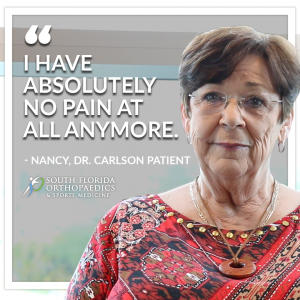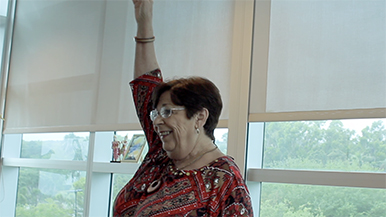Since her total shoulder replacement surgery with William E. Carlson, MD, FAAOS, a board-certified orthopaedic surgeon at South Florida Orthopaedics & Sports Medicine, Nancy’s quality of life has been transformed.
“I can reach the second or third shelf of my cabinets,” says Nancy. “I can get water out of the refrigerator on the top shelf. It’s amazing. I had a total shoulder replacement done on my right shoulder, and it’s totally different. I have absolutely no pain at all anymore.”
Shoulder pain can prevent us from accomplishing the most routine of tasks and severely harm our quality of life. When non-surgical treatment methods fail to alleviate the problem, total shoulder replacement surgery, also known as total shoulder arthroplasty, may offer a viable alternative to address pain and recover normal function of the arm.About 53,000 shoulder replacements are performed every year in the U.S. Total shoulder arthroplasty is done less often than knee or hip replacement; however, medical experts confirm that the procedure is just as effective in alleviating joint pain. According to a recent study, the growth rate of shoulder replacement was equal to or higher than those for total hip and knee replacements.
When Is Shoulder Replacement Surgery Recommended?
 Shoulder replacement surgery is generally used as a last resort and only employed when conservative treatments such as medication, injections, and physical therapy fail to improve symptoms of pain and help the patient reclaim normal use of the arm and shoulder.
Shoulder replacement surgery is generally used as a last resort and only employed when conservative treatments such as medication, injections, and physical therapy fail to improve symptoms of pain and help the patient reclaim normal use of the arm and shoulder.
Shoulder joint replacement may be recommended for extreme pain caused by arthritis or when the shoulder is severely fractured or broken. Arthritis occurs when the cartilage on the ends of the bones erodes leaving bone rubbing on bone in the joint. Arthritis can be caused by fractures, rheumatoid disease, torn rotator cuff tendons or by natural wear and tear over time.
Surgeons began performing total shoulder arthroplasty in the 1950s to treat severe shoulder fractures. Since that time, total shoulder arthroplasty has become a critical tool to address many types of arthritis as well as degenerative joint diseases that can damage the cartilage that supports and stabilizes the shoulder joint including:
- Osteoarthritis
- Rheumatoid arthritis
- Post-traumatic arthritis
- Rotator cuff tears
- Bone fractures
- Failed previous shoulder replacement surgery
How Is Total Shoulder Replacement Surgery Performed?
The shoulder is a ball-and-socket joint. The ball is made up of the upper, round part of the arm bone (humerus). The socket is part of the shoulder blade (scapula). The ball is held in the cavity by ligaments and by the rotator cuff tendons. The rotator cuff muscles start on the shoulder blade and turn into tendons which attach to the ball. As the cartilage erodes and wears down over time, the bones can come into contact with each other, causing pain, discomfort, and stiffness.
In shoulder replacement surgery the ball is replaced with a metal ball attached to a stem. The stem is inserted down the shaft of the humerus and secured in place. The socket sometimes is replaced with a state-of-the-art plastic component which is usually fixed to a groove in the socket with cement.
“I am very impressed with Dr. Carlson (since) the first time I met him,” says Nancy. “He is very reassuring, and I had no qualms about doing the surgery at all. The entire staff is amazing here. They make you feel like you’re part of their family, and they will do anything for you. Dr. Carlson makes you feel very calm. He lets you know that he knows what he’s doing, and that’s worth everything.”
Rehabilitation and physical therapy are critical for a full recovery. Typically, the first day after surgery, patients will work with their doctor on specific exercises to regain full arm and shoulder movement.
Benefits of Total Shoulder Replacement
 Total shoulder replacement surgery has a proven track record of alleviating pain, improving range of motion and function, and enhancing quality of life. However, each patient’s full recovery trajectory will depend on many factors including their personal and medical history, lifestyle, nature of the shoulder damage, and the type of procedure performed.
Total shoulder replacement surgery has a proven track record of alleviating pain, improving range of motion and function, and enhancing quality of life. However, each patient’s full recovery trajectory will depend on many factors including their personal and medical history, lifestyle, nature of the shoulder damage, and the type of procedure performed.
“Reaching up in the cabinet and getting a coffee cup, just reaching on the top shelf of the refrigerator trying to get a bottle of water,” says Nancy. “From the time I came out of surgery, I have had no pain at all. I didn’t take pain medicines. The physical therapist didn’t think I’d had shoulder surgery done because I was doing so well. So it’s been a total 100% improvement.”
